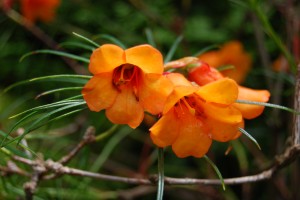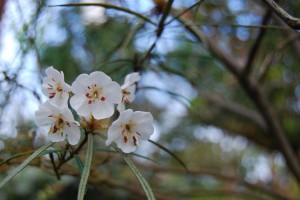Audio by David Mitchell from 2005
Holding collections from the mountain regions of South-East Asia (Borneo to Indonesia and the island of New Guinea) this house showcases one of the long term research groups – the Vireya Rhododendrons. This collection has been built up over numerous expeditions to South East Asia since the 1960s and is now the largest and most important collection of Viryea Rhododendrons in the world.
This section of rhododendron makes up around a third of the genus (approx. 300 species), they need to be kept under glass as they are unable to tolerate the prolonged frosts that we have in Scotland. Some resemble rhododendrons whereas others can look quite different, like Rhododendron stenophyllum which has narrow more or less grass like leaves. They have a wide range of colours, with most shades other than true blue being found. One feature of the Vireya section is that the colour of the flowers tends to intensify as they age. They can also be very heavily scented with some species filling this glasshouse with their scent.
As you enter this house you will see two glass cases, one either side of the entrance, the first display is of orchids from the region, whilst the other displays several genera of carnivorous plants. In this cabinet you can see the range of ways plants have evolved to survive in low nutrient areas like peat bogs, as the captured insects provide a ‘supplement’ their diet. A range of methods have evolved to capture insects, some like the Heliamphora and Nepenthes are pit-fall traps, where the insect falls in to a pool of digestive enzymes; these genera belong to different families and grow on different sides of the globe and are another example of convergent evolution. Others like the Drosera have evolved sticky tendrils on their leaves which trap the insect, you can see the droplets of this mucilage glinting in amongst the mosses and perhaps the most well known of the carnivorous plants is the venus fly trap Dionaea muscipula is able to snap shut around an insect which lands in the modified leaf.



2 Comments
2 Pingbacks